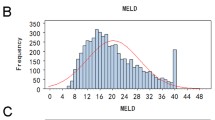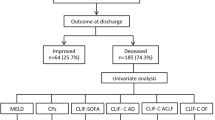Abstract
MELD score is a formula based on laboratory variables used as a predictor of short-term mortality index in cirrhotic patients. It is applied to allocate patients in liver transplantation waiting list in many countries. However, MELD score cutoff point accuracy to predict long term mortality has not been statistically evaluated. The aim of this study was to analyze the MELD score and other variables related to long-term mortality using a new model: the Survival Tree analysis. The variables considered in this study were obtained at the time of liver transplantation list enrollment. The graphical representation of the survival trees showed that MELD 16 was the most statistically significant mortality cutoff point. The results were compatible with the MELD cutoff point reported in the clinical literature. This methodology can be extended to identify significant cutoff points related to other diseases whose severity is not necessarily expressed by MELD.




Similar content being viewed by others
References
Kamath, P. S., Wiesner, R. H., Malinchoc, M., Kremers, W., Therneau, T. M., Kosberg, C. L., et al., A model to predict survival in patients with end-stage liver disease. Hepatology 33(2):464–470, 2001.
Edwards, E. B., and Harper, A. M., Application of a continuous disease severity score to the OPTN liver waiting list. Clin. Transpl. 19–24, 2001.
Fink, M. A., Angus, P. W., Gow, P. J., Berry, S. R., Wang, B. Z., Muralidharan, V., et al., Liver transplant recipient selection: MELD vs. clinical judgment. Liver. Transpl. 11(6):621–626, 2005.
Zapata, R., Innocenti, F., Sanhueza, E., Humeres, R., Rios, H., Suarez, L., et al., Clinical characterization and survival of adult patients awaiting liver transplantation in Chile. Transplant. Proc. 36(6):1669–1670, 2004.
Ransford, R., Gunson, B., Mayer, D., Neuberger, J., and Christensen, E., Effect on outcome of the lengthening waiting list for liver transplantation. Gut 47(3):441–443, 2000.
Fink, M. A., Berry, S. R., Gow, P. J., Angus, P. W., Wang, B.-Z., Muralidharan, V., et al., Risk factors for liver transplantation waiting list mortality. J. Gastroenterol. Hepatol. 22(1):119–124, 2007.
Adler, M., DeGendt, E., Vereerstraeten, P., Degré, D., Bourgeois, N., Boon, N., et al., Value of the MELD score for the assessment of pre- and post-liver transplantation survival. Transplant. Proc. 37(6):2863–2864, 2005.
Lee, Y. M., Fernandes, M., DaCosta, M., Lee, K. H., Sutedja, D., Tai, B. C., et al., The MELD score may help to determine optimum time for liver transplantation. Transplant. Proc. 36(10):3057–3059, 2004.
Hothorn, T., Hornik, K., and Zeileis, A., Unbiased Recursive Partitioning: A Conditional Inference Framework. Journal of Computational and Graphical Statistics 15(3):651–674, 2006.
Cox, D. R., Regression Models and Life-Tables (with discussion). Journal of the Royal Statistical Society Series B 34(2):187–220, 1972.
R Development Core Team, R: A language and environment for statistical computing. R Foundation for Statistical Computing, Vienna, Austria. ISBN 3-900051-07-0, 2009.
Everitt, B. S., and Hothorn, T., A Handbook of Statistical Analyses Using R. Chapman & Hall-CRC Press, Boca Raton, 2006.
Strasser, H., and Weber, C., On the asymptotic theory of permutation statistics. Mathematical Methods of Statistics 8:220–250, 1999.
Perkins, J. D., Halldorson, J. B., Bakthavatsalam, R., Fix, O. K., Carithers, R. L., Jr., and Reyes, J. D., Should liver transplantation in patients with model for end-stage liver disease scores ≤14 be avoided? A decision analysis approach. Liver. Transpl. 15(2):242–254, 2009.
Thuluvath, P. J., Maheshwari, A., Thuluvath, N. P., Nguyen, G. C., and Segev, D. L., Survival after liver transplantation for hepatocellular carcinoma in the model for end-stage liver disease and pre-model for end-stage liver disease eras and the independent impact of hepatitis C virus. Liver Transpl. 15(7):754–762, 2009.
Boin, I. F. S. F., Leonardi, M. I., Pinto, A. O., Leme, R. S. R., Udo, E., Stucchi, R. S. B., et al., Liver transplant recipients mortality on the waiting list: long-term comparison to Child-Pugh classification and MELD. Transplant. Proc. 36(4):920–922, 2004.
Author information
Authors and Affiliations
Corresponding author
Rights and permissions
About this article
Cite this article
do Nascimento, E.M., Pereira, B.B., Basto, S.T. et al. Survival Tree and Meld to Predict Long Term Survival in Liver Transplantation Waiting List. J Med Syst 36, 73–78 (2012). https://doi.org/10.1007/s10916-010-9447-6
Received:
Accepted:
Published:
Issue Date:
DOI: https://doi.org/10.1007/s10916-010-9447-6




